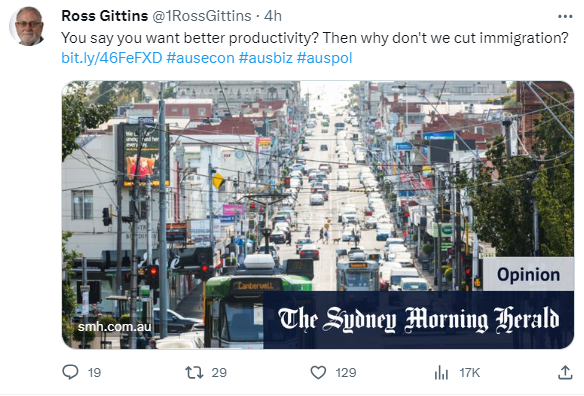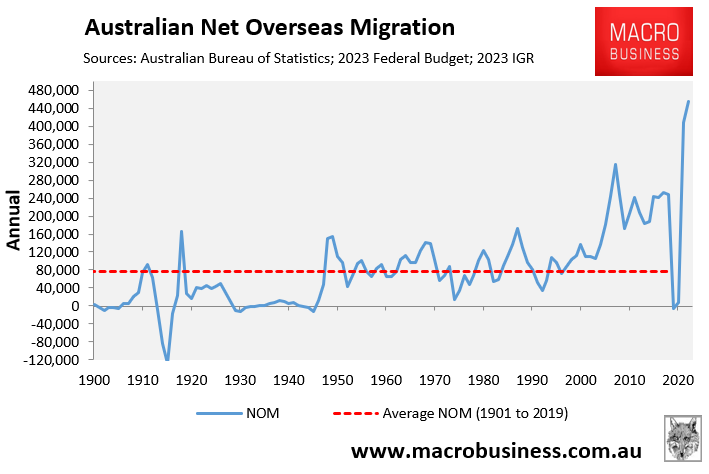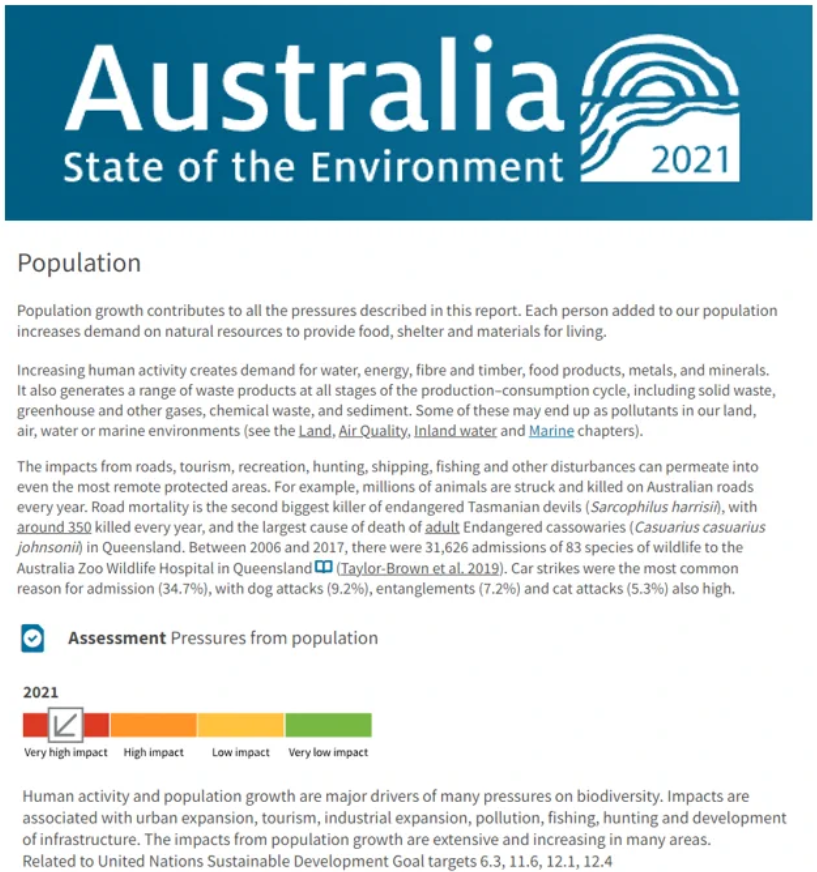In September, I accused Ross Gittins of selling out to the ‘Big Australia’ lobby after penning a series of articles seemingly supporting the Albanese government’s record immigration program.
On Monday, we got a dose of the old Gittins who used to argue against a ‘Big Australia’ on economic, environmental, and liveability grounds.
Gittins argued that cutting immigration is one of the best ways to boost the nation’s productivity growth:

Below are some highlights:
“Whatever economic benefits immigration may or may not bring, it comes with inescapable economic costs”.
“Which are? That every extra person dilutes our existing per-person investment in business equipment and structures, housing stock and public infrastructure: schools, hospitals, police stations, roads and bridges, and much else”.
“In other words, every extra person requires us to spend many resources on preventing this population growth from diminishing our economic and social capital per head, and thereby making us worse off”.
“Economists call this “capital widening”, as opposed to “capital deepening”, which means providing the population with more capital equipment and infrastructure per person”.
“Trouble is, there’s a limit to how much the nation can save – or borrow from overseas – to finance our investment in housing, business equipment and structures, and public infrastructure. So resources we have to devote to capital widening, thanks to population growth, are resources we can’t devote to the capital deepening that would increase our standard of living”.
“Using immigration to raise our living standards is like trying to go up a down escalator. You have to run just to stop yourself going backwards. This is smart?”.
“In practice, it’s worse than that. There’s a big government co-ordination problem. It’s the federal government that’s responsible for immigration levels, and that collects most of the taxes the immigrants pay, but it’s mainly the state governments that are lumbered with organising the extra housing and building the extra sewers, roads, transport, schools, hospitals and other facilities needed to avoid congestion and overcrowding”…
“Is it mere coincidence that productivity improvement has been weak during the period in which immigration-driven population growth has been so strong? I doubt it”..
“Another thing to remember is that the easier you make it for businesses to get the skilled workers they need by bringing them in from abroad, the more you tempt them not to go to the expense and inconvenience of bothering with apprentices and trainees”.
“Have you joined the dots? If giving business what it wants – high immigration to grow the market and provide ready access to skilled and unskilled workers – hasn’t induced business to increase the productivity of its labour, why don’t we try the opposite?”
“Make it harder for business to increase profits without improving productivity and investing in training our local workforce. Of course, this would require us to value productivity improvement more highly than population growth”…
“The strange thing is that the virtue of rapid population growth goes almost wholly unquestioned by the nation’s economists”.
“Population growth is an article of faith for almost every economist. For a profession that prides itself on being so “rational”, it’s surprising how little thinking economists do about the pros and cons of immigration”…
“If there is evidence higher population growth leads to higher income per person, I’ve yet to see it”.
Ross Gittins also blamed high immigration for wrecking the environment:
“As the sustainable population advocates put it: too many people demanding too much of our natural environment”.
“Economists have gone from the beginning of their discipline assuming that the economy and the environment can be analysed in separate boxes. This further assumes that any adverse interaction between the two is so minor it can be safely ignored”.
“In an era of climate change and growing loss of species, this is clearly untenable. The economy and the natural environment that sustains it have to be joined up. But when it comes to population growth, these are dots the profession hasn’t yet joined”.
I have made similar arguments repeatedly for nearly a decade, most recently this month.
Because of record net overseas migration, Australia’s population has expanded by 7.5 million people this century alone.

At the same time, business investment has crashed:

Capital stock per worker has shrunk, leading to “capital shallowing” and declining productivity.
Large-scale population growth has also resulted in capital-city infrastructure constraints, rising congestion costs and diminishing productivity.
Due to diseconomies of scale (e.g., tunnelling and land buy-backs), infrastructure investment required to keep up with population growth is substantially more expensive than in the past.
This means that every new infrastructure unit reduces productivity by increasing average expenditures across the economy.
AMP chief economist, Shane Oliver, noted the productivity destroying impact of Australia’s mass immigration in a recent note:
“Very strong population growth with an inadequate infrastructure and housing supply response has led to urban congestion and poor housing affordability which contribute to poor productivity growth”.
Furthermore, despite the fact that the vast majority of migrants work, Australia frequently imports less productive migrants who earn less than the median salary and have higher unemployment rates than the general population.
Following that, the increased labour supply induced by mass immigration puts downward pressure on wages, causing businesses to avoid investing in labour-saving technologies and automation, which also reduces productivity.
After all, why invest in these productivity savings when you can instead hire low-cost labour?
Large-scale immigration also diverts resources, encouraging expansion in low-productivity “people-servicing” industries while focusing the nation’s productive effort into infrastructure and housing.
Take a look at the next chart of Australia’s labour productivity growth:

Notice how labour productivity spiked over the pandemic when the government ramped stimulus and net overseas migration turned negative?
Australia effectively enjoyed a period of “capital deepening” as the nation’s capital stock was spread over fewer people, which boosted productivity.
However, now that net overseas migration is running at record levels, productivity growth has collapsed because we are getting “capital shallowing” and the nation’s capital stock is being spread over more people.
The most recent 2021 State of the Environment (SoE) Report also stated that “most population-driven pressures are considered to be high or very high impact, and increasing… Population growth contributes to all the pressures described in this report”:

Thus, ongoing rapid population growth via immigration is directly contributing to Australia’s environmental decline.
The federal government must, therefore, slow the migrant intake to a level consistent with the provision of housing, infrastructure, business investment, as well as environmental carrying capacity.
Otherwise, we will achieve the same results as last decade: ongoing sluggish productivity and per capita GDP growth, low wage/income growth, and overall falling liveability as both housing and infrastructure are crush-loaded.

